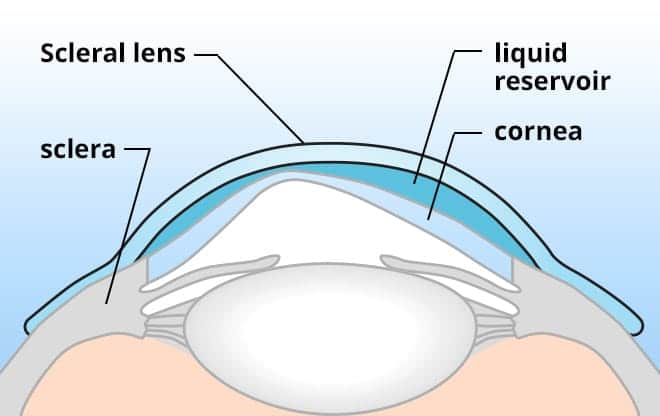Corneal transplant is the end-stage treatment for advanced keratoconus (and other corneal disease) where contact lenses have failed despite expert fitting. But after a transplant, you may still require contact lenses. This is because the surface of your eye can still be irregular after your corneal graft. While a transplant can greatly improve your vision, you may not achieve functional vision adequate for work, driving etc. This is where contact lenses can be of immense value.
Contact lenses after corneal transplant
After a corneal graft, your cornea tends to have a flat central zone and becomes steeply curved towards the edges – a bit like the profile of Uluru. The contact lenses we use are large in diameter and made of rigid gas permeable material. They are larger than the usual kind of hard contact lenses used in fitting other eyes (including keratoconus). By vaulting the irregular central part of the cornea and providing a smooth, even surface, your vision can be greatly improved – usually by several lines on the vision testing chart.
This can make all the difference when it comes to getting your drivers license, enjoying movies, reading, computer work etc.
There are a number of sizes to choose from, depending on what provides a good fit and, most important, good comfort.
There are three design types. Corneal designs are larger than normal, but sit on your cornea only. Mini-sclerals are larger, and extend onto the white of your eye (the sclera). Sclerals are the largest of all, and extend right out onto the sclera. They vault the sensitive cornea and only touch the whites of your eye (sclera), a far less sensitive tissue. Your tears fill the space beneath the hard lens, regardless how irregular your cornea. (See diagram below).

Choosing a contact lens expert after your corneal graft
Complex contact lens fitting is where The Eye Practice excels. Corneal transplantation is an area of vision care that goes well beyond normal optometry. The average eye care practice will see around one or two complex contact lens fittings per year. We see between 5 to 10 per day. The typical patient that sees us for contact lenses has seen at least one optometrist, who has then referred them to an ophthalmologist, who then refers them to a corneal specialist, who then must refer to The Eye Practice for a final vision solution.
Dr Jim Kokkinakis is one of only 40 Members of the International Society of Contact Lens Specialists. He has dedicated his career to giving people their life and vision back, when all else has failed.




























